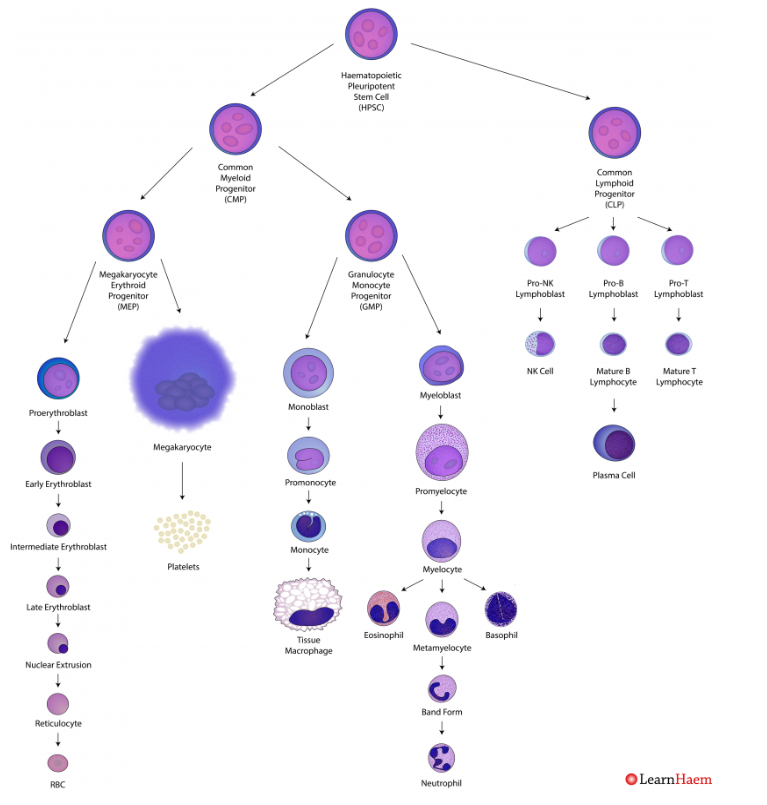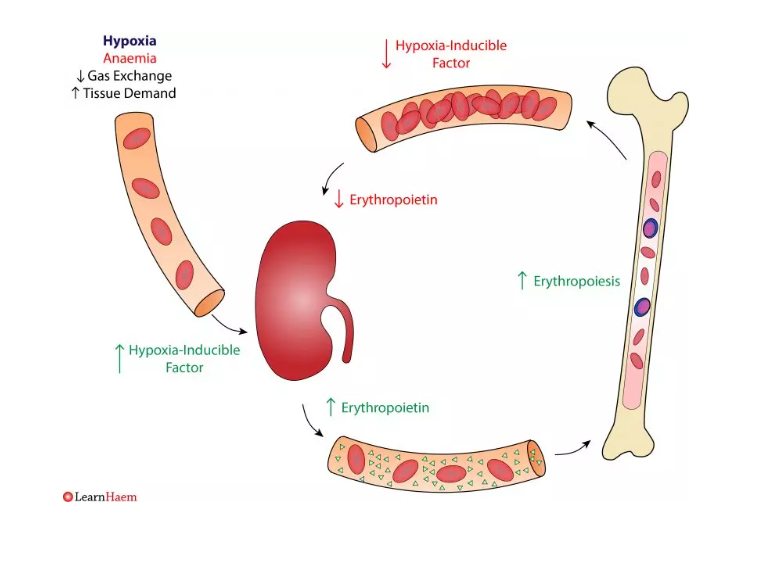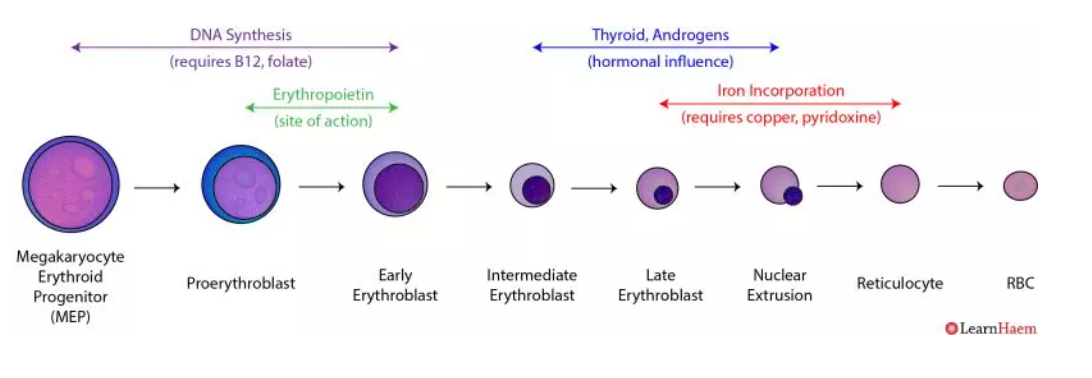

Normal Haematopoiesis
Haematopoiesis is the process by which all blood cells are formed
Haematopoiesis starts with
A Pluripotent stem cell.
This is a rare cell with a unique self-renewal property
which can also differentiate and mature into all cell types.
Haematopoiesis. diagram:
The haematopoietic stem cell (HPSC) differentiates into
common myeloid progenitor (CMP) or common lymphoid progenitor (CLP) cells.
CMPs can general all mature myeloid cells while granulocyte-monocyte progenitors (GMPs) or megakaryocyte-erythroid progenitors (MEPs) produce only myeloid/monocytic and megakaryocytic/erythroid lineage cells respectively.
The common lymphoid progenitor (CLP)
differentiates to give
B and T lymphocytes and NK cells
The haematopoietic stem cell (HPSC) differentiates into
common myeloid progenitor (CMP) or common lymphoid progenitor (CLP) cells.
CMPs can general all mature myeloid cells while granulocyte-monocyte progenitors (GMPs) or megakaryocyte-erythroid progenitors (MEPs) produce only myeloid/monocytic and megakaryocytic/erythroid lineage cells respectively.
The common lymphoid progenitor (CLP)
differentiates to give
B and T lymphocytes and NK cells
Sites of Haematopoiesis
Haematopoiesis
Embryonically - starts in the embryonic yolk sac for a few weeks
Feotally - moves to the foetal liver and spleen
From 6 months gestation - The bone marrow then takes over as the main source of new blood cells
After birth, active red marrow is gradually replaced by yellow fat marrow
so that from age 20,
Haematopoiesis is concentrated in the axial skeleton
and articular ends of the femoral and humerus bones.
Sites of Haematopoiesis (Cellularity in Percentage against Age).
In the developing foetus, haematopoiesis occurs initially in the yolk sac, then transitions to the liver.
By birth, the bone marrow takes over the majority of the haematopoietic function.
Bone marrow cellularity declines with age.
In the developing foetus, haematopoiesis occurs initially in the yolk sac, then transitions to the liver.
By birth, the bone marrow takes over the majority of the haematopoietic function.
Bone marrow cellularity declines with age.

Normal Erythropoiesis
Anaemia Normal Haematopoiesis Normal Erythropoiesis
Erythropoiesis refers to the process by which red blood cells, which carry haemoglobin, are generated.
It occurs at a constant rate during normal health, replacing lost red blood cells (which have an average lifespan of 120 days)
to maintain a constant red cell mass.
It is subject to regulation by a number of factors,
allowing it to respond rapidly in times of stress (e.g. major haemorrhage).
Erythropoiesis.
Erythropoesis starts with a haematopoietic stem cell (see Normal Haematopoiesis), which differentiates into a common myeloid progenitor
and then into a megakaryocyte-erythroid progenitor.
Further differentiation results in commitment to the erythroid lineage.
The proerythroblast is the earliest morphologically identifiable bone marrow red cell precursor,
characterised by a large cell with high nuclear:cytoplasmic ratio, prominent nucleoli and blue cytoplasm (presence of RNA).
As the erythroid cells mature, they become smaller, have more condensed chromatin, lose their nucleoli,
and their cytoplasm changes from blue to pink.
Eventually, the nucleus is extruded, resulting in a reticulocyte.
Most of the process takes place in the bone marrow over three weeks.
The resulting reticulocyte retains some ribosomal RNA to make haemoglobin
and after 1-2 days in the bone marrow,
it enters the peripheral blood where the RNA is lost after 1-2 days
resulting in a mature RBC.

Factors Affecting Erythropoiesis
Erythropoietin and Iron
Erythropoietin is produced in the kidney
and plays a major role in the control of erythropoiesis;
iron is a key mineral required for haemoglobin production.
A lack of erythropoeitin,
which is seen most commonly in renal failure,
can result in profound reticulocytopaenia and anaemia.
In renal failure, where the erythroid precursors are preserved, exogenous erythropoeitin can correct anemia.
Conversely, excessive erythropoietin,
which is either a normal response to hypoxia
or the result of pathological production
(e.g. erythropoietin-secreting tumours), causes erythrocytosis.

Erythropoietin and the Control of Erythropoiesis.
Erythropoietin is produced in the kidney. Hypoxia, which may be caused by
- anaemia,
- impaired gas exchange
- or increased tissue demand for oxygen,
increases the production of hypoxia-inducible factor (HIF),
which in turn stimulates renal production of erythropoietin.
Erythropoietin acts on erythroid precursors,
preventing their apoptosis
and upregulates their transferrin receptors
to stimulate increased RBC production.
The resultant increase in circulating RBCs
relieves the hypoxia,
down-regulating HIF
in a negative feedback loop.
Other Vitamins, Minerals and Hormones

Vitamins and Minerals Influencing Erythropoiesis.
Maturation factors such as B12 and folate
are key components of DNA synthesis. Deficiency of either results in megaloblastic anaemia,
with inefficient DNA replication and selective death of more mature precursors.
Androgens and thyroxine
also exert a stimulatory effect on erythropoiesis.Copper and pyridoxine
are key components of iron incorporation into haem;deficiency of either can result in sideroblastic anaemia.
Normal Red Cell Destruction
Normal red blood cells (RBCs) have no nuclei,
and as such, have a limited capacity to maintain cellular integrity.
After about 120 days in circulation, RBCs
are removed by macrophages in the reticulo-endothelial system (mainly marrow).
The normal red cell cycle is shown below.
and as such, have a limited capacity to maintain cellular integrity.
After about 120 days in circulation, RBCs
are removed by macrophages in the reticulo-endothelial system (mainly marrow).
The normal red cell cycle is shown below.





